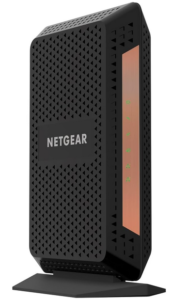During Covid lockdowns our internet was remarkably devoid of problems. No random outages, slowdowns, or hiccups. My theory is that ISPs wisely stepped back on their “network management” (what normal people call brazen violations of net neutrality) in order to avoid massive backlash with the country’s entire office worker and school childr base now dependent in full on network connectivity. Collapsing the American economy must have come up in some board meetings, with perhaps the conclusion that doing so wasn’t the best idea for longterm company financial goals. Whatever the rational, internet access was smooth.
Post-Covid, the shenanigans started to trickle in again. But by that point it was clear that my overall internet speed needed revisiting anyway. The increase in total devices started to eat into available bandwidth, even when idle. And high-bandwidth devices were growing increasingly hungry as accessible content was also growing in fidelity. So finally, I called our ISP for a tier increase.
Naturally, they were quick to take my money. What they neglected to tell me, however, was that they had already grandfathered my plan in to their new base tier. They also failed to mention my modem, which granted I own but they’re still able to see, was incapable of not only the grandfathered speed but also of course the new speed tier. My modem, which supported 100Mb/s, was already obsolete with the upgraded speed of 300Mb/s (which I didn’t know I had), nevermind being incapable of the new speed tier I had just signed up for of 500Mb/s.
I discovered this with a speed test and a quick search of my equipments’ stats. I needed a new modem.

My old modem, the Motorola SB6121, which had replaced a previous Motorola, had served quite faithfully for years. Enough so that, having owned at least 4 Motorola cable modems over the years, I had become brand loyal. However Motorola had since been acquired by ARRIS, so I purchased the ARRIS SB8200. This model supported 1Gb/s with dual gigabit ethernet ports for link aggregation. I was attempting to future-proof.
I also chose this model because it was explicitly listed on the supported modems by my ISP. I also discovered during this research that ISPs now require modem activation. I assume this is to curb stealing cable. That makes me wonder if someone spliced into my coax, could they have plugged in a modem? No doubt that would have caused some IP conflicts, but I guess it would have been possible. So the policy itself didn’t bother me in theory, but it turns out that this security measure would cause some other problems.
Mostly that the activation process failed. In hindsight, I shouldn’t have attempted a hardware upgrade on a Saturday night. Experience has taught me that tenured and/or high-performing customer service reps earn the best schedules, and no one’s going to want to work on a Saturday night, but after the automated activation failed, I didn’t have much choice but to ask for an agent. 6 hours later and I was struggling to get the old equipment running. Eventually I succeeded (but not before having to hard reset my router and do a complete network reconfiguration) and, figuring the modem to be at fault, sent it back. It was months before I attempted another upgrade.

Eventually, the irritation of paying for an internet plan I couldn’t fully use, along with some spousal nagging, build up my courage to try again. This time, I ordered the NETGEAR CM1100. Also a 2-port model, but this one supported 2Gb/s. Again-more future-proofing.
I called on a Thursday afternoon, before 5. Again I attempted the activation through the automated system. And again, I couldn’t get internet despite my router showing connectivity. So I called an agent.
The agent completed a manual activation, and within a few minutes, I was online with full speed. Wondering why the automated activations had failed, he informed me that the automated process is rarely successful. I assume then that the prior agent on my last attempt didn’t know this or simply didn’t bother to push through a manual activation, leaving me with the only remaining possibility that I had bad hardware.
Four months and two modems later, I finally have upgraded speed and I can at long last close this saga. Until the next time I need to upgrade. Because if I ever get beyond gigabit speed I’ll have to buy new switches and a router. So goes the tech race.
–Simon
